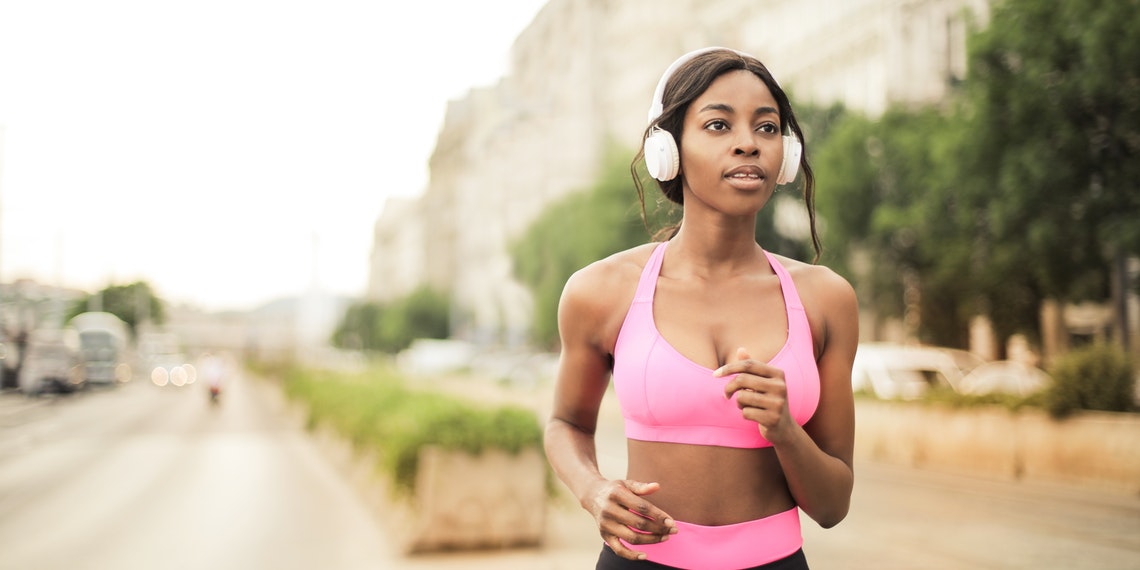Apparently, I had no idea what being “stir-crazy” actually meant until we entered this indefinite solitary confinement they call quarantine. Even as a proud introvert, it feels like the universe is shoving all the plans I’ve ever canceled in my face and screaming, “IS THIS WHAT YOU WANTED?” This is absolutely not what any of us wanted—as any introvert will tell you, part of the thrill is canceling plans. With no plans to cancel, this endless abyss of plans that could have been (canceled) feels like a discount version of Groundhog Day. Not only are we mourning the closures of our favorite restaurants, stores, and bars, but many of the activities that kept us sane are no longer an option. One of the most difficult aspects of my quarantine has been the closure of my gym, and not only because of the sense of community it provided. Physical activity has been one of the only things I’ve found in over a decade of pretty severe anxiety that actually helped keep it in check. According to the CDC, reduced anxiety isn’t the only noticeable benefit of regular physical activity. Just 150 minutes of moderate-intensity exercise each week (that’s like 7 episodes of Schitt’s Creek which, realistically, you’ve done in one day) can improve both your blood pressure and cholesterol levels. Regular exercise can also reduce your risk of certain cancers and cardiovascular disease. So yeah, TL;DR, exercise is good for you and I’m sorry for all the times I pretended I had cramps to get out of gym in high school.
During this time of incredible stress and uncertainty, the anxiety-reducing aspects of physical activity are more important than ever. Being trapped inside a small space with no end in sight is stressful, to say the least. Exercise is definitely helpful, and nothing makes me feel quite as calm as the aftermath of a heart-pounding sweat session. There are plenty of workouts that can be done from the comfort of your own home, but when running is your go-to, working out while quarantined can be a little more complicated (unless you have your own treadmill, you lucky b*tch).
At the beginning of quarantine I was running four miles a day ….. Now I’m proud because I did a single squat
— Donese (@donese22) July 9, 2020
It’s SO tempting—outside is literally right there. You can see it and hear it screaming at you to lace up and get out there. So what’s stopping you? If your neighborhood is anything like mine, you’ve seen countless people jog by, headphones in, totally oblivious to the fact that we’re in the middle of a freaking pandemic. If they can do it, why not the rest of us? Well, because we both know we’re smarter than that. Yes, it’s tempting to squeeze in a quick 3-miler and be back inside before the coronavirus even has a chance to notice we left our bubble. Unfortunately, this isn’t some high-risk game of tag and we really can’t afford to take any chances. Here’s the great news, though—experts say that it is fairly safe to run outside, as long as we take the proper precautions. Family Medicine Physician Doctor Mike Varshavski—or as he’s known on Instagram, Dr. Mike—tells Betches that running “is considered a low to moderate-low risk activity based on the new chart put out by the Texas Medical Association” and notes that “throughout this pandemic, almost all shelter at home orders have continued to allow and encourage solo exercise like hiking, walking, and running.”
So that’s the good news! And as long as you follow these pretty easy guidelines, you can rest easy knowing that you put your safety and the safety of others first.
1. Jog Alone Or In Small Groups, But Make Sure You Maintain A Safe Distance
I get it, running with your best friend or your running group like you’ve done for years is a blast. However, just because you have been extremely cautious about protecting yourself from the coronavirus doesn’t necessarily mean your running partners have done the same. Make sure whoever you’re running with is also taking the proper precautions, and continue to practice social distancing even when running outside. Dr. Mike tells Betches, “any time you are exposing yourself to other individuals, it raises the risk of catching the virus,” reminding us, “those who look healthy can still be spreading COVID-19. If you have to go with a group (for safety reasons, perhaps), try and be with the smallest group possible.”
Brian Labus, Ph.D., MPH, assistant professor in the School of Public Health at the University of Nevada Las Vegas told Runners World, “If you deem running with a small group is something you’re comfortable with, you’ll want to ensure that these few people have been properly careful over the past few months, same as if you’re running with one other person. Additionally, your small group should run somewhere you know you won’t come in close contact with others.”
Labus also emphasizes that if you live with someone in the at-risk age group (over 65) or someone who is immunocompromised, extra precautions are necessary, and running with a partner may not be the best idea. He explains, “There have been over 182,000 cases (as of June 10) and over 77,000 COVID-19 deaths (as of June 6) in those age 65 and over since February 1, according to provisional data from the CDC. It is safer to run solo until disease transmission is low in your community.”
2. Bring A Mask With You When You Run
It’s probably not necessary to wear a mask while you run outdoors (and realistically, it would be really tough to wear a mask during any exercise that leaves you gasping for air) as long as you maintain the proper distance between you and anyone you encounter outside. Indeed, Dr. Mike tells Betches that “a mask should not be worn while running as sweat will make the mask wet and create other problems.” He advises, “The best protection is to wear the mask until you’re ready to exercise, take it off, and stay at least six feet away from others as best as possible.”
That said, it’s probably not a bad idea to bring a mask with you when you run just in case. You may end up lost and needing to grab an Uber back, you could desperately need to run into Walgreens for a drink of water, or you might end up running into your ex and needing a disguise. Point is, there are a lot of reasons you may need a mask when leaving your house, so make sure you have one with you at all times.
Donald Milton, a professor of environmental health at the University of Maryland School of Public Health explained to the New York Times, “Outdoors is relatively safe, and masks would only be important if you are exercising in crowded areas or indoors in space shared with other people.” According to Milton, as long as you’re keeping your distance, you should be pretty fine running outside with your mask at the ready in case of an emergency.
3. Scope Out Your Street During Different Times Throughout The Day, Or Find A Different Street Altogether
Please withhold all “duh”s, because from what I’ve seen firsthand it apparently needs to be said—the easiest way to keep your distance when running outside is to run in a less crowded area. Now, this doesn’t mean driving 38 miles to the middle of the forest to knock out your run. This honestly may be as simple as spending a few days looking out your window every hour or two to see how many people are out and about. Peak hours in your neighborhood may also vary between weekdays and weekends, so also take that into account when planning your run. Ideally, you want to find both a time when not too many people are out, and a place where you have plenty of “escape routes.” This means not running next to a busy street that you can’t cross if you see a group of people on the sidewalk. If you’re running on a forest path, it means being able to step way off to the side if someone else is approaching (and, see #2, don’t forget your mask in case this isn’t an option).
Dr. Benjamin D. Levine, a professor of internal medicine at UT Southwestern Medical Center and Texas Health Presbyterian Dallas, explained to NPR the importance of keeping an even greater distance when exercising outside. He advises, “The greater volume and rate of breathing that occurs during exercise has the risk of spreading droplets farther. I think it’s reasonable based on the known changes in breathing during exercise.”
I don’t know how many times I’ve been out walking and out of absolutely nowhere, a jogger runs by me so close that I feel a small gust of potential plague-wind as they pass. This isn’t okay, guys. First and foremost, if we can’t be considerate to other people who have just as much of a right to use the sidewalk as we do, we shouldn’t be out running in the first place.
That said, if you’ve been keeping an eye on your street and it really doesn’t seem like there’s much of a break in the constant stream of people passing by, check out some other side streets nearby. Chances are, within a mile or so of where you live, there are some quieter residential streets that will be far less congested.
4. Make Sure That It’s Actually Okay To Run Outside In Your Area
View this post on Instagram
now everyone else can hear me heavy breathing too? cool. credit/permission: @itslaurentbtw
As we’ve discussed, it is more than tempting to grab your shoes and just GTFO. But even if you’ve thoroughly read through these important tips and feel confident in your ability to run outside safely, please hit pause for just a hot second. Because of the constantly evolving nature of how we’re handling this pandemic, running outside without a mask may not even be allowed in your area. Make sure you’re constantly checking mandates from your state health departments to ensure you’re adhering to your area’s current requirements. These mandates are changing fairly regularly in some areas, so it’s a good idea to check them daily before your planned run. Your state will most likely have a dedicated coronavirus page with all of the latest information, from things like the number of confirmed cases to reopening guidelines.
Dr. Mike emphasizes, “Know that there is no such thing as absolute safety when outdoors. The guidelines of wearing a mask, physical distancing, and washing hands will certainly reduce risk but not eliminate it. Know what is an acceptable risk for you.”
If you’re still hyped up to go for an outdoor run, more power to you. Just remember the four M’s, and you should be good to go. Maintain your distance, Mask (in your pocket/bra/around your neck/whatever), find tiMes of the day that are less crowded (ok that was a stretch, who cares), and Mandates (check your local mandates to see what rules are in place in your area). Happy running!
Images: Andrea Piacquadio / Pexels; donese22 / Twitter; notskinnybutnotfat, dietstartstomorrow / Instagram




















































